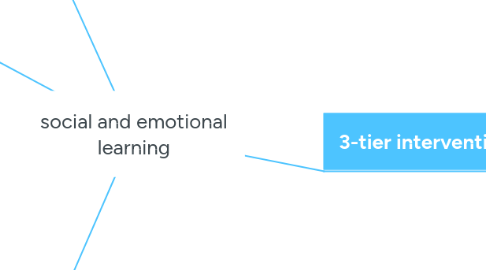
1. why we promote
2. assessment
2.1. what
2.1.1. problem
2.1.1.1. internalized
2.1.1.2. externalized
2.1.2. competence
2.1.2.1. self-awareness
2.1.2.1.1. identifying emotions
2.1.2.1.2. recognizing strengths
2.1.2.2. self-management
2.1.2.2.1. impulse control
2.1.2.2.2. stress-management
2.1.2.3. social awareness
2.1.2.3.1. empathy
2.1.2.3.2. respect
2.1.2.4. relationship skills
2.1.2.4.1. communication
2.1.2.4.2. teamwork
2.1.2.5. responsible decision-making
2.1.2.5.1. task analysis
2.1.2.5.2. solving problems
2.2. how
2.2.1. Achenbach System of Empirically Based Assessment (ASEBA)
2.3. why
3. good intervention
3.1. features (S.A.F.E.)
3.1.1. sequenced
3.1.2. active
3.1.3. focused
3.1.4. explicit
3.2. levels
3.2.1. preschool
3.2.2. elementary
3.2.3. middle
3.2.4. high school
3.3. assumptions
3.3.1. SEL skills are learned behaviours
3.3.2. behavior management problems are SEL skill problems
3.3.3. targeted SEL skills must produce valid outcomes for students
4. 3-tier intervention model
4.1. tier 1- primary - universal
4.1.1. approaches
4.1.1.1. explicit skill instruction
4.1.1.1.1. packaged SEL programs
4.1.1.1.2. free standing instructional activities
4.1.1.2. integration with academic curriculum areas
4.1.1.2.1. infusion approach
4.1.1.3. instructional and classroom practices
4.1.1.3.1. designing classroom environments and engage in behavior that reduce the probability that disruptive behavior will occur
4.1.1.3.2. proactice
4.1.1.3.3. reactive
4.2. tier 2 - secondary - selected
4.2.1. antecedent-based strategies
4.2.1.1. peer-mediated strategies (peer support system)
4.2.1.1.1. 1. identify the target students and behaviors
4.2.1.1.2. 2. selecting peers
4.2.1.1.3. 3. preparing peers
4.2.1.1.4. 4. determine when, where and how the interaction will occur
4.2.1.1.5. 5. providing ongoing feedback and reinforcement to peers
4.2.1.1.6. 6. develop a data collection and record-keeping system
4.2.1.2. check-in/check-out
4.2.1.2.1. 1. identify the target students and behaviors
4.2.1.2.2. 2. create a daily progress report (DPR)
4.2.1.2.3. 3. check-in
4.2.1.2.4. 4. monitoring/evaluation
4.2.1.2.5. 5. check-out
4.2.1.2.6. 6. review the DPR with parents
4.2.1.2.7. 7. develop a data collection and record-keeping system
4.2.2. consequence-based: behavior enhancement interventions
4.2.2.1. token econonmies
4.2.2.1.1. 1. identify the target behaviors
4.2.2.1.2. 2. specify tokens
4.2.2.1.3. 3. choose backup reinforcers
4.2.2.1.4. 4. decide how to deliver tokens
4.2.2.1.5. 5. determine how students will exchange tokens for backup reinforcers
4.2.2.1.6. 6. decide how to address problem behaviour
4.2.2.1.7. 7. determine how to fade the use of the token economy
4.2.2.1.8. 8. develop a data collection and record-keeping system
4.2.2.1.9. 9. teach the token economy to students
4.2.2.2. level systems
4.2.2.2.1. 1. define the levels in the system
4.2.2.2.2. 2. choose the privileges and reinforcers that will be available at each level
4.2.2.2.3. 3. determine the behavioral criteria necessary for students to move from one level to another
4.2.2.2.4. 4. clarify inappropriate behaviors and identify their consequences
4.2.2.2.5. 5. establish how students will move through the level systems
4.2.2.2.6. 6. develop a data collection and record-keeping system
4.2.2.2.7. 7. teach the level system to students
4.2.2.3. behavioral contracting
4.2.2.3.1. 1. select the target behaviour
4.2.2.3.2. 2. identify the reward for fulfilling the terms of the contract
4.2.2.3.3. 3. include a bonus clause, a penalty clause or both
4.2.2.3.4. 4. negotiate, write and sign the behavioral contract
4.2.2.3.5. 5. establish a record-keeping system
4.2.2.3.6. 6. include progress monitoring in the contract
4.2.2.4. group-oriented contingencies
4.2.2.4.1. types
4.2.2.4.2. procedures
4.2.3. consequence-based: behavior reduction interventions
4.2.3.1. response cost 後果自負
4.2.3.1.1. most effective when used in conjunction with token economies
4.2.3.1.2. procedures
4.2.3.2. time-out 冇你份
4.2.3.2.1. 1. enrich the time-in environment
4.2.3.2.2. 2. identify target behaviors
4.2.3.2.3. 3. select the type of time-out and choose the location
4.2.3.2.4. 4. determine the implementation guidelines
4.2.3.2.5. 5. develop a data collection and record-keeping system
4.2.3.2.6. 6. teach the time-out system to students
4.2.3.3. overcorrection
4.2.3.3.1. types
4.2.3.3.2. procedures
4.3. tier 3 - tertiary - intensive
4.3.1. competing behavior model builds
4.3.1.1. Behavior Intervention Plan (BIP) made by
4.3.1.1.1. characteristic
4.3.1.1.2. Functional Behavior Assessment (FBA)
4.3.2. Cognitive Behavioral Intervention (CBI)
4.3.2.1. self-management-based intervention
4.3.2.1.1. self-monitoring 自我監察
4.3.2.1.2. self-evaluation 自我反思
4.3.2.1.3. self-reinforcement 自我獎勵
4.3.2.2. verbal mediation-based intervention
4.3.2.2.1. self-instructional training 記口訣
4.3.2.2.2. alternative response training 替代方法
4.3.2.2.3. problem-solving training 解難
4.3.2.2.4. anger-control training 控制憤怒
4.3.2.2.5. rational emotive behavior training 理性情況行為訓練
